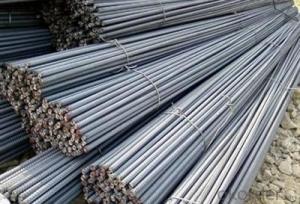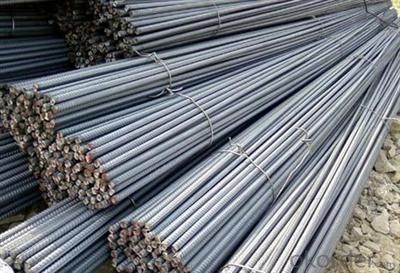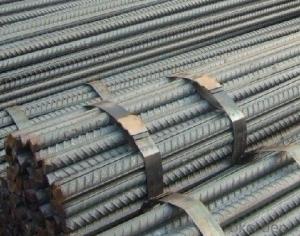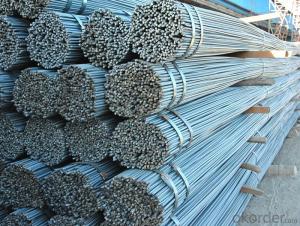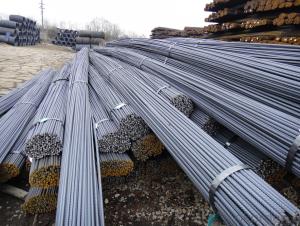Stainless deformed steel bar for construction
- Loading Port:
- Tianjin
- Payment Terms:
- TT OR LC
- Min Order Qty:
- 100000 m.t.
- Supply Capability:
- 10000 m.t./month
OKorder Service Pledge
OKorder Financial Service
You Might Also Like
Specification
OKorder is offering stainless deformed steel bar deformed steel bar at great prices with worldwide shipping. Our supplier is a world-class manufacturer of steel, with our products utilized the world over. OKorder annually supplies products to European, North American and Asian markets. We provide quotations within 24 hours of receiving an inquiry and guarantee competitive prices.
Product Applications:
G460B deformed steel bar deformed steel bar are ideal for structural applications and are widely used in the construction of buildings and bridges, and the manufacturing, petrochemical, and transportation industries.
Product Advantages:
OKorder's deformed steel bar are durable, strong, and resist corrosion.
Main Product Features:
· Premium quality
· Prompt delivery & seaworthy packing (30 days after receiving deposit)
· Corrosion resistance
· Can be recycled and reused
· Mill test certification
· Professional Service
· Competitive pricing
Product Specifications:
Manufacture: Hot rolled
Grade: HRB335
Size: 6mm-25mm
Certificates: ISO, SGS, BV, CIQ
Length: 6m – 12m, as per customer request
Packaging: Export packing, nude packing, bundled
Grade | Technical data of the original chemical composition (%) | |||||||
C | Mn | Si | S | P | B | |||
HRB335 | ≤0.25 | ≤1.60 | ≤0.80 | ≤0.045 | ≤0.045 | >0.0008 | ||
Physics capability | ||||||||
Yield Strength(N/cm2) | Tensile Strength(N/cm2) | Elongation (%) | ||||||
≥335 | ≥490 | ≥16 | ||||||
Usage and Applications of HRB400 Deformed Steel Bar:
Deformed bar is widely used in buildings, bridges, roads and other engineering construction. Big to highways, railways, bridges, culverts, tunnels, public facilities such as flood control, dam, small to housing construction, beam, column, wall and the foundation of the plate, deformed bar is an integral structure material. With the development of world economy and the vigorous development of infrastructure construction, real estate, the demand for deformed bar will be larger and larger..
Packaging & Delivery of HRB400 Deformed Steel Bar:
Packaging Detail: products are packed in bundle and then shipped by container or bulk vessel, deformed bar is usually naked strapping delivery, when storing, please pay attention to moisture proof. The performance of rust will produce adverse effect.
Each bundle weight: 2-3MT, or as required
Payment term: TT or L/C
Delivery Detail: within 45 days after received advanced payment or LC.
Label: to be specified by customer, generally, each bundle has 1-2 labels
Trade terms: FOB, CFR, CIF
FAQ:
Q1: Why buy Materials & Equipment from OKorder.com?
A1: All products offered byOKorder.com are carefully selected from China's most reliable manufacturing enterprises. Through its ISO certifications, OKorder.com adheres to the highest standards and a commitment to supply chain safety and customer satisfaction.
Q2: How do we guarantee the quality of our products?
A2: We have established an advanced quality management system which conducts strict quality tests at every step, from raw materials to the final product. At the same time, we provide extensive follow-up service assurances as required.

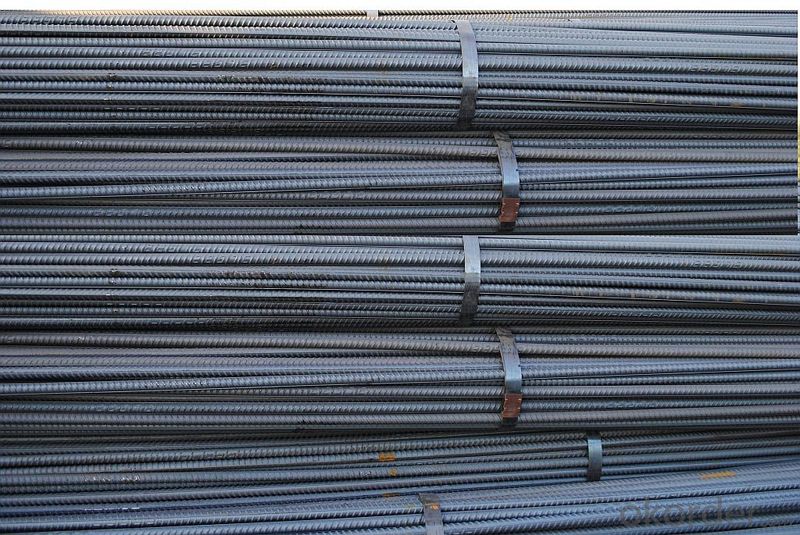
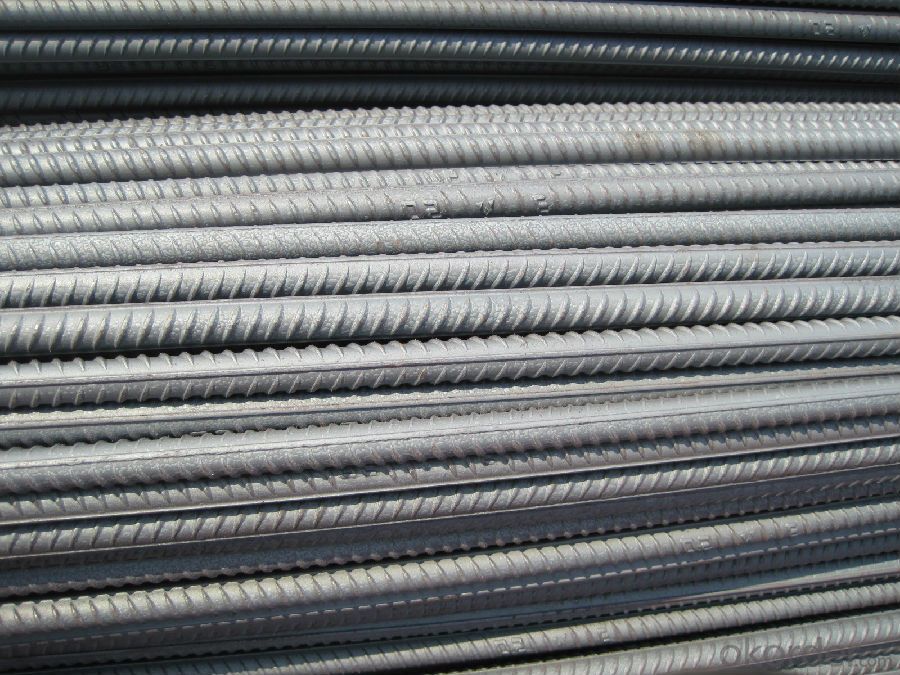
- Q: Are steel rebars suitable for use in high-temperature applications?
- High-temperature applications are generally not suitable for the use of steel rebars. Despite being a strong and durable material, steel has limitations when exposed to high temperatures. It can undergo a significant reduction in strength and even a loss of structural integrity, leading to potential failures. When subjected to high temperatures, steel goes through a process known as thermal expansion, which can weaken and deform it. This phenomenon is particularly noticeable in rebars, which are commonly used to reinforce concrete structures. The high temperatures cause the rebars to expand, exerting excessive pressure on the surrounding concrete. This pressure can result in cracks and potentially compromise the stability of the structure. Furthermore, prolonged exposure to high temperatures can cause a loss of the steel's mechanical properties, including its tensile strength and load-bearing capacity. As a result, the rebars become less effective in resisting external forces and reinforcing the concrete. For this reason, it is generally recommended to consider alternative materials, such as stainless steel or special alloys, for high-temperature applications. These materials are specifically designed to withstand elevated temperatures without compromising their structural integrity. To ensure safety and structural stability, it is important to consult with experts and engineers who are familiar with high-temperature applications in order to determine the most suitable materials for specific projects.
- Q: How are steel rebars protected from corrosion in marine environments?
- Steel rebars are protected from corrosion in marine environments through the application of a protective coating, such as epoxy or zinc, or by using stainless steel rebars that have inherent resistance to corrosion. Additionally, concrete cover is provided to rebars to isolate them from direct contact with seawater, further enhancing their protection against corrosion.
- Q: What is the standard diameter of steel rebars?
- The standard diameter of steel rebars typically ranges from 6mm to 32mm.
- Q: How do steel rebars affect the overall thermal performance of a structure?
- Steel rebars can have a significant impact on the overall thermal performance of a structure. Due to their high thermal conductivity, steel rebars can act as thermal bridges, allowing heat to easily transfer from the warmer side to the cooler side of a structure. This can result in heat loss in cold climates and heat gain in hot climates, thereby reducing the overall energy efficiency of the building. To mitigate this effect, insulation materials can be used to separate the steel rebars from the building envelope and minimize thermal bridging.
- Q: Can steel rebars be bent or shaped during construction?
- Yes, steel rebars can be bent or shaped during construction. They are commonly used in reinforced concrete structures and can be bent to fit the required design, shape, or structure.
- Q: What are the common mistakes to avoid when handling and storing steel rebars?
- To ensure the quality and longevity of steel rebars, it is crucial to steer clear of certain common mistakes. Here are some errors that should be sidestepped: 1. Inadequate storage conditions: The storage of steel rebars in damp or wet areas can result in corrosion and rust. To prevent moisture accumulation, it is vital to store them in a dry and well-ventilated space. 2. Insufficient support: To prevent bending or deformation, it is important to provide proper support when stacking rebars. Insufficient support can damage the rebars and compromise their structural integrity. 3. Improper lifting techniques: It is essential to employ appropriate lifting equipment and techniques when handling rebars. Using hooks or chains directly on the rebars can weaken and damage them. It is advisable to use lifting devices specifically designed for rebar handling. 4. Overloading: Avoid placing excessive weight on storage racks or platforms. Overloading can cause structural failure and pose a risk to workers. Always adhere to the manufacturer's guidelines for maximum weight capacity. 5. Lack of protection: Rebars should be shielded from moisture, dirt, and other contaminants. Wrapping them properly with plastic or waterproof covers can prevent corrosion and maintain their quality. 6. Improper transportation: During transportation, take care to secure the rebars adequately to prevent movement or damage. Using appropriate restraints and padding can prevent potential accidents or rebar displacement. 7. Mixing different grades: Do not mix rebars of different grades together, as they possess varying strength and performance characteristics. Mixing different grades can compromise the overall structural integrity of the construction project. 8. Neglecting quality control: Conduct regular quality checks on the rebars to ensure they meet the required specifications. Neglecting quality control can result in the use of substandard rebars, jeopardizing the safety and durability of the structure. By avoiding these common mistakes, construction professionals can guarantee the proper handling and storage of steel rebars, leading to safer and more durable structures.
- Q: Can steel rebars be used in underground construction projects?
- Yes, steel rebars can be used in underground construction projects. Steel rebars are commonly used for reinforcement in concrete structures, including those built underground. They provide strength and durability to the construction, making them suitable for various underground applications such as tunnels, basements, and underground parking structures.
- Q: How do steel rebars affect the overall creep and shrinkage of concrete structures?
- The overall deformation of concrete structures can be significantly affected by steel rebars. Creep, which refers to the long-term deformation of concrete under sustained load, and shrinkage, the reduction in volume during drying and hardening, are both influenced by rebars. To control and mitigate both creep and shrinkage, steel rebars play a crucial role. When embedded in concrete, rebars enhance the load-carrying capacity and provide tensile strength to the structure. This reinforcement allows for stress distribution and limits deformation over time. In terms of creep, steel rebars minimize its effects by reducing stress transferred to the concrete. By absorbing a significant portion of the load applied, rebars alleviate strain and reduce creep deformation. Furthermore, rebars help control cracking caused by creep, thus preserving the concrete's structural integrity. Regarding shrinkage, steel rebars also impact its magnitude. As concrete shrinks during drying and hardening, rebars act as restraints, preventing excessive volume reduction. By resisting contraction forces, rebars minimize the potential for cracking and maintain the concrete's structural stability. It is important to consider the type, size, and spacing of rebars as they can affect the overall impact on creep and shrinkage. Proper design and placement, including appropriate cover thickness, are necessary to ensure optimal performance and minimize long-term deformations. In conclusion, steel rebars play a vital role in controlling creep and shrinkage in concrete structures. By providing reinforcement, distributing stress, and preventing cracking, rebars maintain the structural integrity of concrete over time.
- Q: What are the guidelines for the proper spacing of steel rebars in beams?
- The guidelines for the proper spacing of steel rebars in beams typically depend on the specific design requirements and the structural engineer's recommendations. However, in general, rebars should be spaced evenly throughout the beam to ensure adequate structural integrity and load-bearing capacity. The spacing should be determined based on factors such as the beam's dimensions, the anticipated loads, and the type of reinforcement being used. It is essential to follow the relevant building codes and industry standards to ensure the proper spacing of rebars in beams for optimal structural performance.
- Q: Can steel rebars be used in structures with high resistance to UV radiation?
- Structures with high exposure to UV radiation typically do not recommend the use of steel rebars. Traditional carbon steel rebars are vulnerable to corrosion when exposed to UV radiation. The sun's rays can degrade the protective oxide layer on the surface of the steel, leading to rust and deterioration over time. Furthermore, UV radiation can cause the steel to expand and contract, weakening its overall strength and structural integrity. To address these concerns, alternative materials like stainless steel rebars or epoxy-coated rebars are commonly employed in structures that require high UV radiation resistance. Stainless steel rebars possess greater corrosion resistance and durability when exposed to UV radiation. Epoxy-coated rebars have a protective layer of epoxy coating that shields the steel from direct UV radiation, mitigating the risk of corrosion. Consulting structural engineers and professionals is crucial in determining the appropriate type of rebars for structures with high UV radiation resistance. Factors such as the specific environment, climate conditions, and project requirements should be carefully considered to ensure the structure's longevity and safety.
Send your message to us
Stainless deformed steel bar for construction
- Loading Port:
- Tianjin
- Payment Terms:
- TT OR LC
- Min Order Qty:
- 100000 m.t.
- Supply Capability:
- 10000 m.t./month
OKorder Service Pledge
OKorder Financial Service
Similar products
Hot products
Hot Searches
Related keywords
